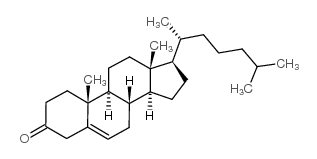(3β)-(3-2H)Cholest-5-en-3-ol
Modify Date: 2024-01-10 17:19:19

(3β)-(3-2H)Cholest-5-en-3-ol structure
|
Common Name | (3β)-(3-2H)Cholest-5-en-3-ol | ||
|---|---|---|---|---|
| CAS Number | 51467-57-3 | Molecular Weight | 387.66 | |
| Density | 1.0±0.1 g/cm3 | Boiling Point | 480.6±14.0 °C at 760 mmHg | |
| Molecular Formula | C27H45DO | Melting Point | N/A | |
| MSDS | N/A | Flash Point | 209.3±12.4 °C | |
Use of (3β)-(3-2H)Cholest-5-en-3-olCholesterol-d1 is the deuterium labeled Cholesterol. Cholesterol is the major sterol in mammals and is makes up 20-25% of structural component of the plasma membrane. Plasma membranes are highly permeable to water but relatively impermeable to ions and protons. Cholesterol plays an important role in determining the fluidity and permeability characteristics of the membrane as well as the function of both the transporters and signaling proteins[1][2]. Cholesterol is also an endogenous estrogen-related receptor α (ERRα) agonist[3][4]. |
| Name | cholesterol-3-d1 |
|---|---|
| Synonym | More Synonyms |
| Description | Cholesterol-d1 is the deuterium labeled Cholesterol. Cholesterol is the major sterol in mammals and is makes up 20-25% of structural component of the plasma membrane. Plasma membranes are highly permeable to water but relatively impermeable to ions and protons. Cholesterol plays an important role in determining the fluidity and permeability characteristics of the membrane as well as the function of both the transporters and signaling proteins[1][2]. Cholesterol is also an endogenous estrogen-related receptor α (ERRα) agonist[3][4]. |
|---|---|
| Related Catalog | |
| In Vitro | Stable heavy isotopes of hydrogen, carbon, and other elements have been incorporated into drug molecules, largely as tracers for quantitation during the drug development process. Deuteration has gained attention because of its potential to affect the pharmacokinetic and metabolic profiles of drugs[1]. |
| References |
| Density | 1.0±0.1 g/cm3 |
|---|---|
| Boiling Point | 480.6±14.0 °C at 760 mmHg |
| Molecular Formula | C27H45DO |
| Molecular Weight | 387.66 |
| Flash Point | 209.3±12.4 °C |
| Exact Mass | 387.361145 |
| PSA | 20.23000 |
| LogP | 9.85 |
| Vapour Pressure | 0.0±2.7 mmHg at 25°C |
| Index of Refraction | 1.525 |
|
~% 
(3β)-(3-2H)Chol... CAS#:51467-57-3 |
| Literature: Murari, Martha P.; Murari, Ramaswamy; Baumann, Wolfgang J. Magnetic Resonance in Chemistry, 1985 , vol. 23, # 4 p. 243 - 245 |
|
~% 
(3β)-(3-2H)Chol... CAS#:51467-57-3 |
| Literature: Suginome, Hiroshi; Furusaki, Akio; Kato, Kimitoshi; Maeda, Norio; Yonebayashi, Fumihiko Journal of the Chemical Society, Perkin Transactions 1: Organic and Bio-Organic Chemistry (1972-1999), 1981 , p. 236 - 250 |
| Precursor 1 | |
|---|---|
| DownStream 0 | |
| 3-deuteriocholesterol |
| Cholest-5-en-3-d-3-ol, (3β)- |
| (3β)-(3-H)Cholest-5-en-3-ol |
| 3-2H-cholesterol |
| <3-Trifluormethyl-phenyl)-<2-hydroxy-aethyl>-thioharnstoff |

